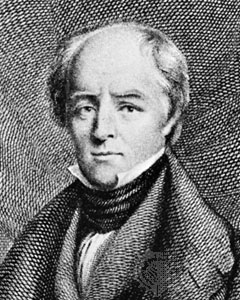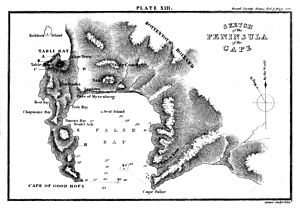Basil Hall facts for kids
Quick facts for kids
Basil Hall
|
|
|---|---|
 |
|
| Born | 31 December 1788 Edinburgh, Scotland |
| Died | 11 September 1844 (aged 55) Royal Hospital Haslar, Portsmouth, England |
| Service/ |
Royal Navy |
| Years of service | 1802–1823 |
| Rank | Captain |
Basil Hall FRS (1788–1844) was a British naval officer, explorer, and writer from Scotland. He was born in Edinburgh and came from a family interested in science. His father, Sir James Hall, was a famous scientist.
Contents
Basil was born in George Square, Edinburgh, Scotland, in 1788. He went to the Royal High School and joined the Royal Navy when he was just 14 years old in 1802. He worked his way up, becoming a Lieutenant in 1808 and later a Captain.
Exploring the World by Ship
Captain Hall sailed on many ships that were part of important missions. These missions often involved exploring new places, doing scientific research, or even meeting with leaders from other countries. From the very beginning of his time in the navy, his father encouraged him to write down everything he saw and did in a journal. These journals later became the basis for many of his popular books about his travels.
Witnessing History and Danger
While serving on a ship called HMS Endymion, Basil Hall saw a famous British general, Sir John Moore, being carried away after being badly hurt in the Battle of Corunna.
In 1810, he sailed to a tiny, rocky island called Rockall on the Endymion. In 1811, he was part of the very first group of people to land there. He wrote about his exciting and sometimes dangerous adventures in a book called Fragments of Voyages and Travels.
Scientific Discoveries and Observations
Basil Hall was also interested in science. In 1813, he worked with Professor John Playfair to describe some interesting rock formations he saw near Table Mountain in South Africa. Years later, another famous scientist, Charles Darwin, studied the same types of rocks.
In 1813, Hall explored Java, an island in Indonesia. Later, in 1816, he joined a diplomatic mission to China. During this trip, he surveyed the west coast of Korea and the Ryukyu Islands of Japan. He wrote a book about these travels, which was one of the first times a European described Korea in detail.
Hall's journals also tell the story of a terrible shipwreck in 1815, when a ship called the Arniston was lost. He was very critical that the ship didn't have a special clock called a marine chronometer, which helps sailors figure out their exact location at sea. He believed that not having this important tool led to many lives being lost.
In 1817, Basil Hall even had the chance to interview Napoleon, the famous French leader, when Napoleon was exiled on the island of St. Helena.
South American Adventures
In 1820, Captain Hall took command of HMS Conway and sailed to the west coast of South America. He returned to England in 1823. His journals from this journey became another book, Extracts from a Journal Written on the Coasts of Chile, Peru and Mexico.
After leaving the navy in 1823, Basil Hall married Margaret Congalton in 1825. They had a daughter named Eliza.
Helping a Famous Author
In 1826, when the famous writer Sir Walter Scott was feeling very sad and had financial problems, Basil Hall helped him. He arranged for Scott to take a trip to Naples and even convinced the government to provide a ship for him.
Travels in North America
In 1828, Basil Hall and his wife went on a two-year trip across North America. They traveled through places like Charleston, South Carolina, and Savannah, Georgia. Hall wrote a book about his experiences called Travels in North America (1829). Some people in America were not happy with his criticisms of American society in the book.
Famous Writings and Later Life
His most well-known work is The Fragments of Voyages and Travels, which was published in several volumes between 1831 and 1840. He also wrote articles for the Encyclopædia Britannica and scientific papers on various topics, including trade winds and the geology of Table Mountain.
Basil Hall became ill and passed away in 1844 at the age of 55.
See also
- Hendrick Hamel
Images for kids





